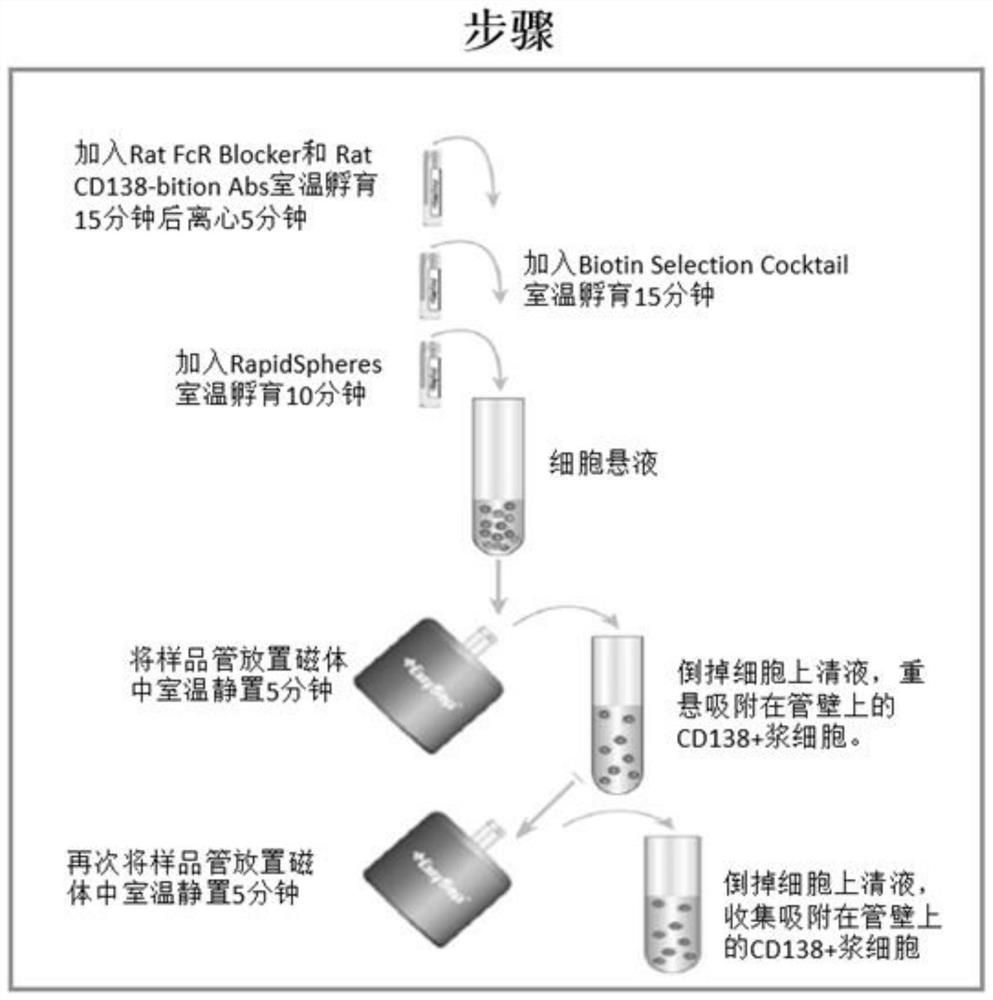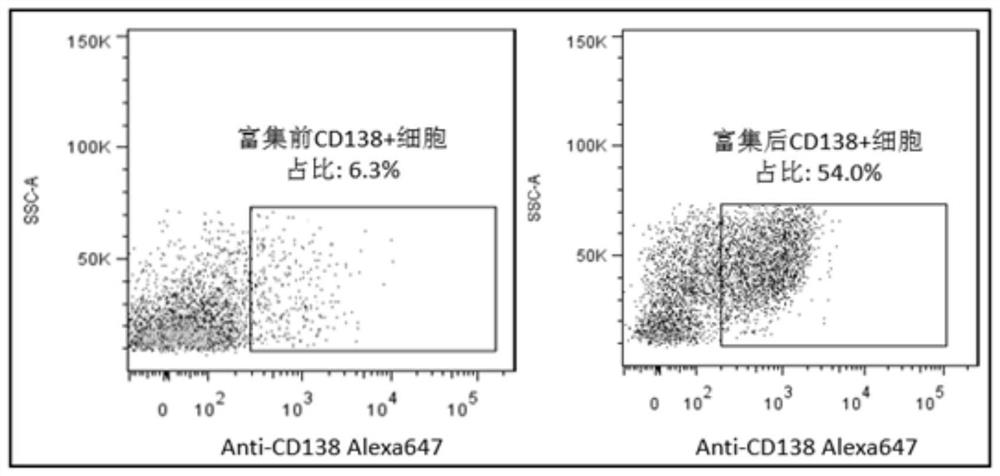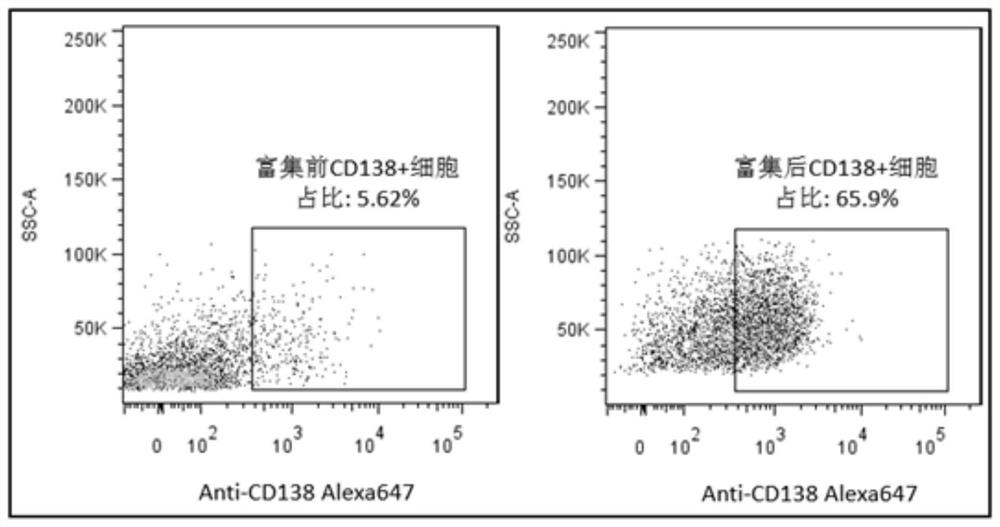Method for enriching rat plasma cells and establishing plasma cell hybridoma
A technology for plasma cells and hybridomas, applied in the field of enriching rat plasma cells and establishing plasma cell hybridomas, which can solve the challenges of increasing new drug antibody screening and specific antibody screening, high-throughput screening of antibodies, heavy workload, and manpower time and high capital costs, to achieve the effects of reducing the formation of invalid hybridomas, saving manpower and material costs, and reducing the number of plates
- Summary
- Abstract
- Description
- Claims
- Application Information
AI Technical Summary
Problems solved by technology
Method used
Image
Examples
Embodiment 1
[0046] Example 1 Preparation of specific anti-rat CD138 monoclonal antibody
[0047] In a specific embodiment, specific anti-rat CD138 monoclonal antibody is prepared by using hybridoma technology with rat CD138 as the target. In blood cells, CD138 acts as a plasma cell-specific biomarker. The CD138 antibody specifically binds to the CD138 protein on the surface of plasma cells, and can isolate antibody-secreting plasma cells from a large number of lymph and spleen cells. The plasma cells undergo hybridoma fusion, which greatly increases the positive rate and diversity of hybridoma antibodies. However, rats are an important platform for hybridoma antibody technology. At present, there is no specific anti-rat CD138 antibody for enriching high-purity rat plasma cells, so traditional rat hybridoma technology can only use low-purity plasma cells. Fusion produces a large number of "ineffective hybridomas", which seriously affects the positive rate and diversity of rat hybridoma an...
Embodiment 2
[0061] Example 2 Enrichment of Rat Plasma Cells
[0062] In a specific embodiment, the biotin-labeled anti-rat CD138 antibody in Example 1 is used to enrich rat plasma cells. The biotin-labeled anti-rat CD138 antibody specifically binds to the rat plasma cells that secrete the antibody, binds with high affinity between biotin and streptavidin, and finally enriches the rat plasma cells by magnetic bead adsorption. The kit used for the enrichment of rat plasma cells in the present invention is: STEMCELL, EasySep TM Biotin Positive Selection Kit II (Catalog #17683).
[0063] Rat plasma cell enrichment process materials are as follows:
[0064]
[0065] Rat plasma cell enrichment experiment steps are as follows:
[0066] 1) To prepare a plasma cell enrichment buffer, add 2% FBS and 1 mM EDTA to PBS without calcium and magnesium ions, and filter to sterilize with a 0.22 μm filter membrane.
[0067] 2) Separation of spleen and lymph node tissues from immunized rats, and then...
Embodiment 3
[0076] Embodiment 3 Fusion and Screening of Rat Plasma Cells
[0077] In a specific embodiment, the spleen and lymph node tissues are isolated from the immunized SD rats, and ground into a cell homogenate through a glass grinder. Divide the cells into two parts, one part is used for traditional hybridoma fusion, first treat with red blood cell lysate to remove red blood cells, and then perform cell fusion with mouse myeloma cells; the other part of cells refers to the plasma cell enrichment method in Example 2 Rat plasma cells are enriched, and finally the enriched rat plasma cells are fused with mouse myeloma cells.
[0078] Rat plasma cell fusion and screening steps are as follows:
[0079] 1) Rat plasma cells were isolated according to the enrichment method in Example 2. Rat plasma cells were resuspended with DMEM basal medium, transferred to a 15ml centrifuge tube, thoroughly mixed and counted, centrifuged at 2000rpm for 5 minutes, and set aside.
[0080] 2) Collect the...
PUM
 Login to View More
Login to View More Abstract
Description
Claims
Application Information
 Login to View More
Login to View More - R&D
- Intellectual Property
- Life Sciences
- Materials
- Tech Scout
- Unparalleled Data Quality
- Higher Quality Content
- 60% Fewer Hallucinations
Browse by: Latest US Patents, China's latest patents, Technical Efficacy Thesaurus, Application Domain, Technology Topic, Popular Technical Reports.
© 2025 PatSnap. All rights reserved.Legal|Privacy policy|Modern Slavery Act Transparency Statement|Sitemap|About US| Contact US: help@patsnap.com



